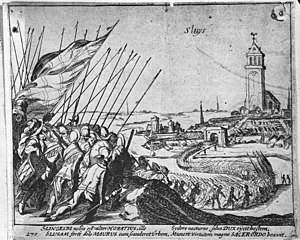Siege of Sluis (1604)
| Siege of Sluis (1604) | |||||||||
|---|---|---|---|---|---|---|---|---|---|
| Part of the Eighty Years' War & the Anglo–Spanish War | |||||||||
 The capture of Sluis by the Dutch and English army in 1604 from the Atlas Van Loon |
|||||||||
|
|||||||||
| Belligerents | |||||||||
|
|
|
||||||||
| Commanders and leaders | |||||||||
|
|
|
||||||||
| Strength | |||||||||
| 11,000 | 15,000 4,200 (Sluis) |
||||||||
| Casualties and losses | |||||||||
| 800 casualties, sick or dead to disease | 2,000 casualties, sick or dead to disease 5,800 captured 10 Galleys 15 assorted ships 1,400 Slaves released |
||||||||
The Siege of Sluis (1604) also known as the Sluis Campaign or the Battle of the Oostburg Line was a series of military actions that took place during the Eighty Years' War and the Anglo–Spanish War from 19 May to 19 August 1604. A States and English army under Prince Maurice of Orange and Horace Vere respectively crossed the Scheldt estuary and advanced on land taking Cadzand, Aardenburg and IJzendijke in the Spanish Netherlands. This soon led to the culmination of the siege of the Spanish held inland port of Sluis.
Initially it was hoped that with Ostend under siege for three years by the Spanish, an attempted relief by Maurice's army could be achieved. Even though Ostend would finally fall into the hands of the Spanish, Sluis an important stronghold itself was eventually captured after tough fighting which included the defeat of a Spanish relief force under Ambrogio Spinola and Luis de Velasco.
In 1600 the Dutch and English Army under the command of Maurice of Nassau and Sir Francis Vere respectively, used Ostend as a base to invade Flanders. After their victory at the Battle of Nieuwpoort an attempt was made to conquer the city of Dunkirk which had been harbouring privateers against the English and Dutch navies. This never happened however as disputes in the Dutch command meant that taking Spanish occupied areas in the rest of the Netherlands took priority as the opportunity arose. Maurice concurred and had his forces evacuated by sea leaving Ostend to be preoccupied by the Spanish.
...
Wikipedia
